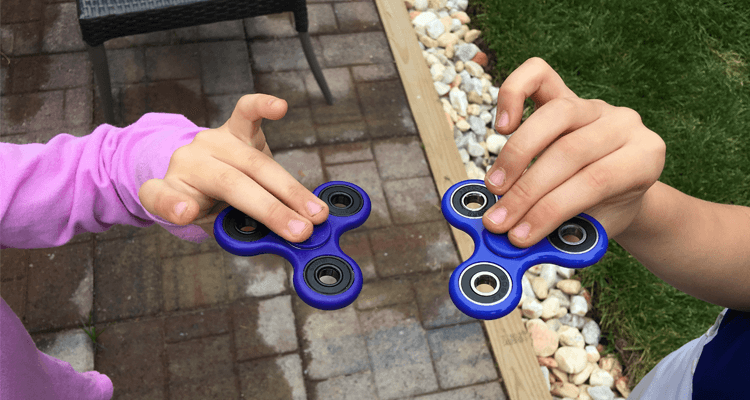It is the hottest kid’s toy to sweep the country—so hot, in fact, that it’s even available at 7-Eleven convenience stores nationwide. Even cats are playing with them now! This is the colorful and oddly satisfying contraption known as the fidget spinner. If you have kids, odds are good you have one of these at home. Or, you will soon. (And more schools are requesting that you keep it at home and out of your children’s classrooms).
What Is a Fidget Spinner?
Fidget spinners are surprisingly low-tech—there are no batteries or chargers associated with this fad. The toy looks a bit like a handheld ceiling fan with two or three paddle-shaped blades and a round, smooth-spinning ball bearing in the center. To “operate” it, simply grasp the round center with your thumb and index finger, and give it a big spin with a finger on your opposite hand. The best fidget spinners will spin for minutes on that one spin, emitting a calming whirring sound and a mesmerizing kaleidoscope of color. (Although, the value for kids who need to fidget is in its ability to keep spinning over and over again.) That’s it. While some fancy models sell for upward of two hundred dollars, many cost less than ten dollars. They are available in a rainbow of colors and materials, and some even glow in the dark.
Why Are They Flying Off Store Shelves?
The current popularity of fidget spinners probably has more to do with the fad factor and less to do with why the device was invented in the first place: to help kids focus. Research shows that movement, repetition, and even rituals have a calming effect and keep the mind from wandering. Spinning the toy is believed to comfort kids with ADHD by giving them a physical outlet for excess energy and hyperactivity, which advocates say will help them concentrate.
Learning Aids: Spinners, Cubes, Putties, and Chewys
An entire category of toys (aids) is marketed to help students and adults who struggle with the effects of ADHD. Plus, firm research backs up the assertion that fidgeting helps kids with ADHD stay focused and improve their performance at school. Like fidget spinners, fidget cubes (with options to flip, click, roll, or spin) keep habitual fidgeters’ fingers occupied, alleviate stress and anxiety, and encourage concentration.
Many kids diagnosed with ADHD also have sensory processing issues, which can manifest as a strong aversion to sounds or feelings, or a strong desire for intense sensory stimulation. To address the latter, products like squeeze balls, Slinkies, Silly Putty, Playdough, Velcro strips, and chewy necklaces can be used in the classroom to let students fidget without distracting the rest of the class.
Spinner Backlash
Fidget spinners and other devices may legitimately help kids who suffer from ADHD, yet many more kids are bringing them to school. As a result, these devices have been deemed a learning hindrance rather than a learning tool. Schools across the country are banning the devices, noting how they have become a distraction. In addition, there have been reports of kids being injured when the spinners are thrown around at lunch or recess.
Some educators are advocating policies that allow usage for special-education kids with an Individualized Education Program in place. If your child has ADHD, autism, or a sensory processing disorder, and he or she can legitimately benefit from a spinner or other banned device, you might consider talking to your school’s administrators. Some schools are making exceptions for therapeutic use. You may also consider a less traditional school environment where your child would have more freedom to use these types of learning tools such as in a virtual school. Visit K12.com for more information.





































